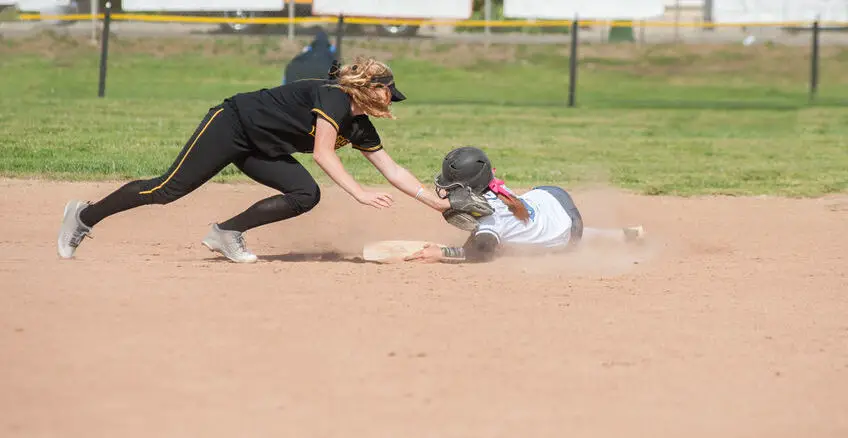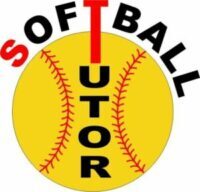
Any time the ball is fielded with runners on base, the first goal is to get the lead runner. The Shortstop Double Play play at second is the most common double play because of how close the middle infielders are to the base for the throw. The high percentage of runners at first base and the time it takes the runner to get to first base from the batters box gives this play a good chance for success. How the second baseman plays a double play will depend on where the ball is fielded and where the receiving player is in relation to second base. There are a few options for the double play depending on the runner.
Second Base Player Double Play Options
- If the runner is on the way to second and the second base player fields the ball, she can attempt to tag the runner then throw to first for the double play. If she misses the tag, and moves the runner out of the base path, the runner is out because she left the base path. If she misses the runner and the runner stays in the base path, she should throw to second for the lead runner if she can. If there is no play on the lead runner and there is no threat of the lead runner advancing, she needs to throw to first quickly for the sure out. This might also depend on the inning and the score of the game.
- Tag second base and throw to first for the double play. This option is preferred if possible because the less people that have to handle the ball the less chance there is for an error.
- Throw to the shortstop at second base. Make sure the throw is at a good height to assist in the transfer for the throw to first base. Practice this because sometimes the thrower is afraid to throw without the other player there to catch it. Throw to the base and assume the shortstop will be there to catch the ball and make the play. Where the throw goes will also dictate the pivot that is used.
- If it is a line drive, throw to first right away for a runner who has left without getting back in time for the force back at first base.
Shortstop Double Play
Options
- After fielding the ball, she moves across second base for the out at second and then throws to first for the double play.
- With runners at first and second, she tags the runner heading to third and throws or tosses to second for the double play. The same rules apply with regard to the baseline as with the second base player.
- If it is a line drive, as with the second base player, she looks to throw to a base where there is a runner who jumped off too far and can not get back to the base for the force out. Be careful though because if there is a runner at second or third, and she throws to first with less than 2 out, the lead runner or runners could advance. The score and inning are important factors in this potential play.
- Throw to second baseman at second to turn the double play.
Double Play
If a ground ball is fielded by the shortstop with a runner on first, it will be the second base player who takes the base to turn the double play. If the second base player fields the ball, then the shortstop will be the player who takes the throw at second. It is more common for the second baseman to field as most balls will be fielded on the left side of the field.
Regardless of which player is at second for turning the play, she needs to have her glove out as a target while she is approaching the base for the throw. The receiver must also anticipate a bad throw so that she is ready to make adjustments and not allow any further advancement of the runners if the ball goes to the outfield. For this reason it is very important that the back up players such as outfielders are in good position.
Step Back Play
Step on the near edge of the base with the glove side foot, keeping the throwing side foot in a good position to transition to a throw. Catch the ball at shoulder height with both hands. Immediately take the ball back to the throwing side ear in preparation for a snap throw. Step back off the base to clear the base path on the outfield side of the base, and transfer body weight to the throwing side foot. Push off and throw with a step toward first. Follow through directly toward first base.
The step back pivot is usually used when the baseman is a little late getting to the base or when the ball is fielded close to the base. It is also used when the runner is close and approaching from the outfield side of the base line. It requires a strong arm.
Step Across Play
The shortstop steps on the base and towards the outfield making sure she doesn’t miss the base . Catch the ball at shoulder height with both hands. Immediately take the ball back to the throwing side ear in preparation for a snap throw. Clear the base path on the infield side of the base, and transfer body weight to the throwing side foot. Push off that foot and throw with a step toward first on the glove side foot. Follow through directly toward first base.
The step across pivot is generally regarded as the most desirable. It is also one of the quickest and easiest for most players to learn. It is used when the player is a little early getting to the base or when she catches the ball on the third base side. It is also used when the runner is close and approaching from the infield side of the base line.
Step Away Play
She steps on the left field side of the base with the left foot, reaches for the ball stepping toward it with the right foot. She quickly gets into throwing position, then makes a snap throw to first base. The throwing arm follows through directly toward first base.
This pivot is used mostly when the throw is wide to the target.
Right Foot Drag Play
The shortstop steps over the base, or base path in the direction of the approaching ball. She makes the catch and drags the rear foot across the base and into a throwing position. She then makes a snap throw to first base with or without a crow hop.
This play is most often used when the ball has been thrown wide to the left of the shortstop. It can be a difficult play to make. If it is necessary to leave the base to make the catch, she should either tag the approaching runner or throw to first base for an attempted force of the batter baserunner.
Base Line Play
The shortstop waits for the throw from a set position behind the base, to the right field side. She steps on the front first base side of the base while making the catch, and snaps a throw with a step toward first on the glove side foot.
This is one of the fastest double plays because her body remains in the base path. it is used when the advancing runner is a distance away and there is no immediate threat of contact.
There are other varieties of the shortstop double play. Most players will find that one or two methods are easier and more natural for them. It is good to be able to use at least two plays successfully. One to the infield side of the base line and one to the outfield side. This will make it hard for the runner coming from first to guess where to slide if she wants to break up a double play. Double plays are important to practice. They need to be automatic and natural without errors.
The throws to first should be quick and accurate. A snap throw, similar to that used by a catcher, is recommend. If no play is possible, on the back runner, the ball should be held.
